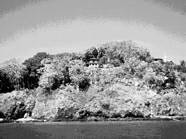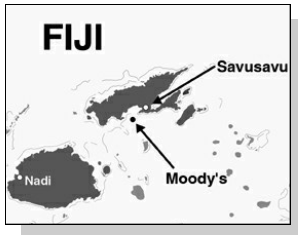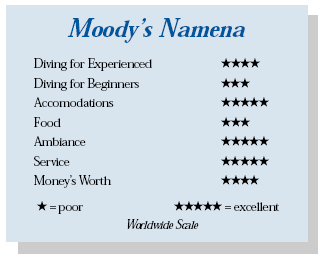Moody’s Namena, Fiji, South PacificContents of this Issue: Moody’s Namena, Fiji, South Pacific Diver Dies from Blood Clot During Flight When the Little Boy Comes, the Big Boys Leave Equipment in Diver Accidents and Deaths DAN Faces Off with DEPP on Dive Equipment Insurance Editorial Office: Ben Davison Publisher and Editor Undercurrent 3020 Bridgeway, Suite 102 Sausalito, CA 94965 a romantic hideaway with fine diving from the April, 2002 issue of Undercurrent
Dear Fellow Diver: About 60 feet down a coral drop-off called the Tetons, our divemaster Cecil pointed out a brilliant sixinch blue ribbon eel. I admired its neon color for a few moments, and then turned to see a squadron of four-foot Spanish mackerels cruising the blue water. With that half turn, I was swimming in a totally different ocean. On the rest of my leisurely 60 minute drift in 100 foot visibility, I also saw a tiny pipefish, a yellow leaf fish, a lobster, and a lionfish, all in full color as deep as 40 feet. A perfect dive. Along the 10-mile barrier reef surrounding the island of Namenalala, I had several chances to enjoy the wonderful dichotomy between macro wall life and blue-water pelagics. On the walls and seamounts (or “bommies,” as the Aussies call them), hard corals were profuse and variegated, though bleached in some places, evidence of El Nino. Beautiful, multi-hued soft corals, fauna for which Fiji diving is justifiably famous, swayed like seductive South Seas dancers. At times I had to tear myself away from flatworms, clownfish in anemones, tangs, Moorish idols and other beauties foraging among the corals to check out spotted groupers, a 200 lb. potato cod, barracuda and four, 4 ft. white-tip sharks behind or below me. It was like having two dives in one. Nearly every dive ended with a safety stop at the reef top, where I was romanced by coquettish demoiselles and damselfish, neon anthias, butterfly fish, regal angels, and two-tone chromis. It beat the hell out of chilling out on an anchor line.
All this, right off one of the more romantic, secluded and charming destinations, I would say, this world has to offer. The 110-acre Namenalala island is occupied only by Moody’s Namena, a retreat that houses but twelve guests in six hand-crafted bures (cottages) secluded among trees and jungle vegetation. Moody’s takes up 10 acres of the island; the rest is crisscrossed by jungle paths leading to dramatic cliffs or secluded beaches... as close as you can get to a “Survivor” scenario. Uninhabited for centuries because there was no fresh water, Namenalala was leased from Fijian tribal leaders by American expats Tom Moody and his wife Joan (who pronounces it “Jo- Ann”) nearly 20 years ago. They had operated a small resort in Panama’s San Blas islands, but were chased out by violent locals as Noriega rose in power. Hardly the folks to give up, they scoured the Pacific for a place they could call their own. (Tom says the Caribbean has been overrun by the drug trade). Eventually they found the mile-long Namenalala, where they created a world with little interference from the outside. They named their hideaway Moody’s Namena, dropping the suffix “lala,” which means “empty” in Fijian. The hillside resort overlooks a cove haboring a collection of boats and a rudimentary dive center. Upon my arrival, Fijian brothers Cecil and Ted stowed my dive gear in the beach shack. I walked up 106 steps (I had many opportunities to count every one) and then followed a winding flowered path to the main building, which is decorated with carved Fijian war clubs and masks, as well as opulent hibiscus plants and cut blossoms. Following Fijian custom, shoes are forbidden. The romantic and isolated guest bures feature floor-to-ceiling sliding wooden doors on three sides to maximize the view and let the trade winds waft thru. The centerpiece of my room was a canopied king-sized bed with mosquito netting (it was needed at night) and a bright blue bedspread pattered with sea life. What luxury to drop the netting, pull down the blankets, and drift off to the sounds of the breeze in the trees, birds chirping away, the Pacific lapping gently below, and small seed pods and twigs dropping on the corrugated metal roof. On either side of the bed were matching desks/vanities. His-and-her wardrobe areas flanked the shower. Local hardwood flooring and a cross-thatched palm ceiling completed the cozy tropical decor. The bures are perfect examples of South Pacific charm and Yankee ingenuity. Each has its own propane tank, which heats the shower water and a propane hot plate for coffee, and lights the gas lamps. Roof gutters capture rainwater -- the sole source of fresh water -- which is stored in a cistern below the floors. Seawater is pumped up for flushing toilets. A solar panel powers a small reading light and fan over the bed (the only electricity in the place, though one day Tom turned on the generator so we could charge appliances and strobes). Here, a hair dryer is a vestigial organ. Now in his 70’s, Tom Moody has slowed down from the days when he used to free
dive to 50 feet to swim alongside scuba divers. Today he travels his island on an
all-terrain-vehicle and oversees the diving and maintenance operations, leaving the
diving to the brothers. Built like a bulldog, Moody is fiercely independent, and
hardly loath to share his opinions, which he laces with down-home humor. (While
describing Fiji’s recent coup attempt, he stated that the insurrection had been
backed by a U.S. firm that had been trying to win a lumber contract; he also said
to never give Fijians alcohol because they can’t handle it -- doesn’t that reflect
something of a colonial attitude? At six each evening the sounds of the lali, or log drum, beckoned us for cocktails and munchies. We gathered on padded chairs around a large coffee table strewn with fish ID books, and socialized while watching geckos on the ceiling stalk moths. Dinners were served at two large round family-style tables. Moody hosted one while Joan did the honors at the other. Meals, which always included fresh bread and an iceberg lettuce, tomato and onion salad, were hearty American: oven-fried chicken, linguini with tomato sauce, mahi-mahi (caught that day by one of the guests) with French fries, plantains, and cole slaw; loin lamb chops with boiled broccoli and cauliflower, and fried casaba sticks from local roots; one night tough, overcooked beef kabobs. Desserts were typically spice or chocolate cake, cheesecake with mango topping, or peanut butter pie. Breakfasts included cereal, fresh fruit and eggs, and even banana-coconut pancakes. Buffet lunches offered rigatoni with ground beef and cheese, potato leek soup, salad; fried rice with chicken; meat or veggie pizza, salad with crunchy nuts; and pasta, cabbage, or veggie soup. Once they served sandwiches of filet of sailfish, caught the day before. Joan tries to accommodate dietary restrictions and special requests. A passable Aussie wine was included with dinner, which John the waiter graciously poured, using my name each time he asked if I’d like a refill. After dinner, I trundled off to bed using the flashlight provided to help me navigate the paths. Nightlife on Namena means a little stargazing and maybe reading in bed. Everyone I dealt with seemed genuinely sincere. When our maid Maria asked if I’d slept well, she sounded as if she truly cared. I forgot my flashlight one night. When a staff person heard me mention it, he rushed to my bure to fetch it. Dining family style made it easy to connect with the varied clientele: initially, three New Zealanders who were scouting the island for future birding tours, a snorkeler from Australia with his wife, and a California couple with their daughter, who were the only other divers. Even when the resort is full it’s rare that all guests dive. Judging by the cramped deck space on the dive boat, that is definitely good news. You see, the dive boat is a basic cabin cruiser with benches and tank racks along the gunnels. The covered dive deck has a carpeted table for loose equipment, but there is no separate camera table. Although the colorful scenery would be photographers’ paradise, Moody isn’t set up to accommodate them. He said, however, that if a photographer or someone else asked to dive alone instead of drifting with the group, he’d provide a small boat and skipper, depending on conditions and available manpower. Divers store fins and weights in cubbies beneath the benches. There’s a head
below the v-berth in the forward cabin, but it was a well-kept secret until I asked.
One of the crew slept on the berth most of the time. While a sign indicated that a
DAN oxygen setup was on board, no one briefed us on it. Moody told me I’d have a checkout dive at the dock, but when everybody got aboard, we motored out to the “Chunnel,” a pair of bommies. Cecil sketched the area on a white board and outlined the plan to circumnavigate the first bommie and then try for the second if the current allowed. As on most dives, the boat would follow our bubbles, picking up each diver as he surfaced. Geared up, I waddled to the stern swim step, where Ted steadied me. After a giant stride, I dropped to the bottom to meet Cecil. As on most dives, Cecil led the way while Ted hung back with the stragglers. Although Ted is older -- both are in their twenties -- he hasn’t been certified as a divemaster, so he serves as Cecil’s assistant. Both were very helpful, solicitous, and well-trained divers. It was a treat to listen to Cecil’s dive briefings in his mellifluous Fijian accent. Like all the staff, they live in separate quarters on the island, getting home to visit their families only rarely. The first outing didn’t live up to my expectations. Water in August (Fiji’s winter) was a brisk 77° F and visibility was no more than 60 feet. The current prevented us from getting to the second bommie. And the fish life was sparse, although I did see a leopard shark. When I surfaced, the boat was nearby. I handed up my tank and climbed the ladder with my fins on, kneeling on the swim step while one of the crew helped me pull them off. It was a short, smooth ride back to the cove. At the dock we left all our gear on board and the divemasters took our wetsuits and regs/BCs ashore to rinse them for us. Moody offers two single-tank boat trips daily, all within sight of the island. While we could make unlimited day or night shore dives, when I snorkeled around the cove there was nothing to see but a few giant clams that Tom had transplanted from the reefs to keep them from local fishermen. He and Joan consider the island and its reef a preserve, and allow no taking of anything underwater. When she spotted two native fishermen out on the reef, she reported them to friends on the main island who, she said, would take discipline “into their own hands.” Hmmmm. Later in the week, the diving improved considerably. At an unmarked passage in the barrier reef, I had a spectacular drift along a sheer wall etched with spur and groove cuts. The hard and soft corals were sumptuous. The current was strong due to the full moon’s effect on the tides, so I glided along gazing at the wall as if I were rubbernecking out a car window. Visibility was 100 feet, and I could clearly see a snorkler 50 feet above. Snorkelers are welcome on the dive boat as long as it isn’t full and conditions are suitable. With seven divers on the boat -- more had arrived during the week -- I kept my seat until most had left the swim step. On the bottom, Ted pointed out a tiny cleaner shrimp, then a short while later, we were surrounded by at least a hundred barracuda, circling like Indians around a wagon train. As we drifted, everyone stayed in sight of one another, but we were free to select any depth we chose. The only rule was to surface with 500 psi; buddy teams didn’t have to surface together. Visibility generally deteriorated to 50 feet or less in the afternoons, but this barely detracted from such special sightings as tiny leaf scorpion fish, garden eels, lumbering cods and groupers, and potted sweetlips. At the Chimneys, a school of unicorn fish escorted me from one bommie to another. At Rainbow Reef we encountered a boat from the Cousteau Fiji Resort, an hour ride from Vanua Levua. One diver, who had come from Cousteau Fiji, told us that guests there who had been to Namena were pleading to return. Once under water, I could see why. The coral heads were full of brilliant tube worms, and between them I watched a large titan trigger grazing on the bottom. Flowery soft corals looked like fireworks that had fallen into the sea. Feather stars adorned sea fans like corsages on lace dresses. At Fish Patch, 5 ft. gray reef sharks and 3 ft. groupers patrolled among hordes of small barracuda. At 90 feet I came upon an enormous lion fish and later a curious white tip made a close inspection. During breakfast we saw that the Fiji Aggressor was on the site. As Joan remarked, “The Aggressor lives up to its name,” diving wherever it pleases, even in the “domain” of shore-based operations. However, the Aggressor’s divers were out of the water by the time we went overboard, so we had the scene all to ourselves . Throughout the week, Cecil and Ted proved very helpful, pointing out critters, adjusting equipment, and serving as pleasant hosts. Cecil even fixed the balky hot water heater in my bure, which had been cutting out all week long. Still, a few lapses made me certain not to take anything for granted. While suiting up for one dive, I noticed that Cecil and Ted had forgotten to connect my BC’s power inflator. Another time, they switched my regulator (computer and all) with my dive buddy’s. So I double-checked their work before every dive. Initially disappointed that Moody scheduled only two dives each day, I soon got into the laid-back lifestyle. After diving I would shower and then slip into a complementary unisex wraparound called a “sulu” and sit out on the deck that ran around five sides of my bure, watching white long-tailed tropic birds glide inches above the water. Fruit bats soaring and climbing from branch to branch at eye level made me feel like I was living in a tree house. Occasionally I thought about taking a walk to one of the secluded beaches on the far side of the island, but usually I just flopped on my canopied to read for about five minutes before succumbing to a blissful nap. One afternoon my companion and I had Nautilus beach all to ourselves. The water was too shallow for snorkeling, so we collapsed in a couple of hammocks strung between coconut palms to watch frigate birds soar overhead. At dinner that night the other divers told me they had returned to Fish Patch and encountered a sailfish underwater. I decided not to bore them with the story of my frigate bird sighting. One morning I took one of Moody’s sit-on-top kayaks out for a cruise around the cove -- a very short cruise, as it turned out. The trade winds blowing in my face made it tough for a single paddler to hold the two-person kayak on course. While the remoteness of Namena is part of its charm, there are downsides. I arrived in L.A. on an American Airlines flight only to find that my Air Pacific departure had been delayed. So I spent the first night of my vacation at a Holiday Inn Express in the airport’s flight path. After a ten-hour flight to Nadi, I caught a Sun Air puddle jumper to Savusavu and then hopped a chartered fishing boat for a refreshing (meaning damp) ninety-minute ride to the resort. As it turned out, none of my connections on Sun Air or Air Pacific left on time, coming or going. But since each airline seemed to be in the habit of waiting for the other, the only real damage was to my nerves, not my itinerary. Another drawback on Namena is that guests miss the opportunity to sample the Fijian culture. The staff, however, did organize a kava ritual Saturday night. The traditional local drink, Kava is made by pounding pepper tree roots and then mixing the powder with water. One ceremoniously chug-a-lugs it to the accompaniment of singing and hand-clapping. With a flavor I would guess taste like dirty dishwater, it’s a mild tranquilizer. The only effect I felt was a numb tongue, but then again one should not precede it with a gin and tonic. Before the boat came to take me back to Savusavu, I had time to walk to the high point of the island (407 feet) to view the remains of an ancient ring fortification. Once again, my hot water had failed, but a cold shower felt good after that jungle trek. The kitchen crew packed a lunch for the boat ride, and I said goodbye with genuine regret. -- D.L.
|

I want to get all the stories! Tell me how I can become an Undercurrent Online Member and get online access to all the articles of Undercurrent as well as thousands of first hand reports on dive operations world-wide
| Home | Online Members Area | My Account |
Login
|
Join
|
| Travel Index |
Dive Resort & Liveaboard Reviews
|
Featured Reports
|
Recent
Issues
|
Back Issues
|
|
Dive Gear
Index
|
Health/Safety Index
|
Environment & Misc.
Index
|
Seasonal Planner
|
Blogs
|
Free Articles
|
Book Picks
|
News
|
|
Special Offers
|
RSS
|
FAQ
|
About Us
|
Contact Us
|
Links
|
3020 Bridgeway, Ste 102, Sausalito, Ca 94965
All rights reserved.


 My editor said he noted the same in Panama). Joan is the nerve-center of Namena, clucking
over guests like a mother hen, helping to
rearrange travel plans, and still managing
to be a gracious hostess. Once home, I
continued to get e-mails from her asking
about my flights and how I’d liked her
Nadi restaurant recommendation. As isolated
as Namena seems, Joan keeps the operation
linked to the outside world.
My editor said he noted the same in Panama). Joan is the nerve-center of Namena, clucking
over guests like a mother hen, helping to
rearrange travel plans, and still managing
to be a gracious hostess. Once home, I
continued to get e-mails from her asking
about my flights and how I’d liked her
Nadi restaurant recommendation. As isolated
as Namena seems, Joan keeps the operation
linked to the outside world. After I set up my regulator
and BC the first time, divemasters took care of rerigging fresh tanks.
After I set up my regulator
and BC the first time, divemasters took care of rerigging fresh tanks. Diver’s Compass: To avoid missing connections due to airline
delays, it would be wise to schedule at least one extra day in
or around Nadi before and after traveling to the island. . . .
Nadi has plenty of resorts and recreational activities that
could be booked in advance. . . .Moody does not schedule specific
departure or arrival dates; they’re willing to charter
the boat at any time to transport guests to Savusavu. . . . .
The flight from Nadi to Savusavu was $172 round trip. They can
arrange sea plane charter for $750 RT. Rates for Moody’s are $354/person/double
($255 for a single occupant) plus 10% Value Added Tax. (pay for indicentals with
checks or cash, no credit cards) They include meals and boat transfers. Minimum
stay is five nights. My travel agent (Reef and Rainforest in Sausalito, CA; 1-800-
794-9767) booked a seven-night package for the price of five.Diving is $45/tank.
Sport fishing is extra. . . . Individual tipping is antithetical to Fiji’s tribal
culture, but we were encouraged to donate cash to the staff’s Christmas fund. . . .
Bring all your own dive gear and replacements. Moody’s stocks only a small supply
of well-worn basic equipment. . . . The resort closes in March and April. Guests
often email Joan ahead of time and offer to bring a few hard-to-find items from the
States — it’s a wonderful icebreaker for anyone visiting a new resort. Moody sells
you a full bottle of basic hooch ($19 for a bottle of gin) and mixers at their
cost, or local beer or soft drinks (buy your favorite brand in the duty-free shops
at Nadi Airport and bring it along). For more information, log onto
Diver’s Compass: To avoid missing connections due to airline
delays, it would be wise to schedule at least one extra day in
or around Nadi before and after traveling to the island. . . .
Nadi has plenty of resorts and recreational activities that
could be booked in advance. . . .Moody does not schedule specific
departure or arrival dates; they’re willing to charter
the boat at any time to transport guests to Savusavu. . . . .
The flight from Nadi to Savusavu was $172 round trip. They can
arrange sea plane charter for $750 RT. Rates for Moody’s are $354/person/double
($255 for a single occupant) plus 10% Value Added Tax. (pay for indicentals with
checks or cash, no credit cards) They include meals and boat transfers. Minimum
stay is five nights. My travel agent (Reef and Rainforest in Sausalito, CA; 1-800-
794-9767) booked a seven-night package for the price of five.Diving is $45/tank.
Sport fishing is extra. . . . Individual tipping is antithetical to Fiji’s tribal
culture, but we were encouraged to donate cash to the staff’s Christmas fund. . . .
Bring all your own dive gear and replacements. Moody’s stocks only a small supply
of well-worn basic equipment. . . . The resort closes in March and April. Guests
often email Joan ahead of time and offer to bring a few hard-to-find items from the
States — it’s a wonderful icebreaker for anyone visiting a new resort. Moody sells
you a full bottle of basic hooch ($19 for a bottle of gin) and mixers at their
cost, or local beer or soft drinks (buy your favorite brand in the duty-free shops
at Nadi Airport and bring it along). For more information, log onto
